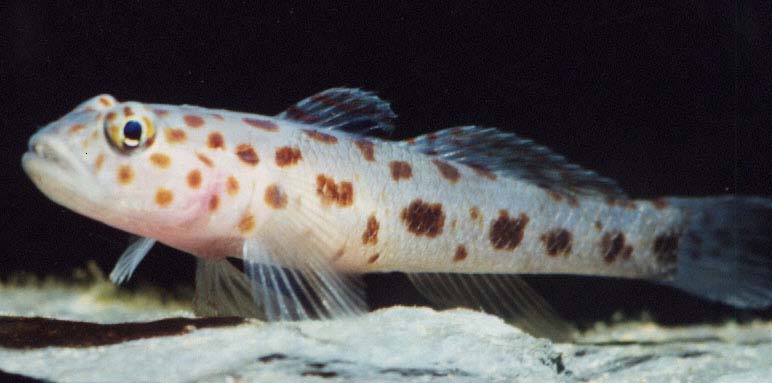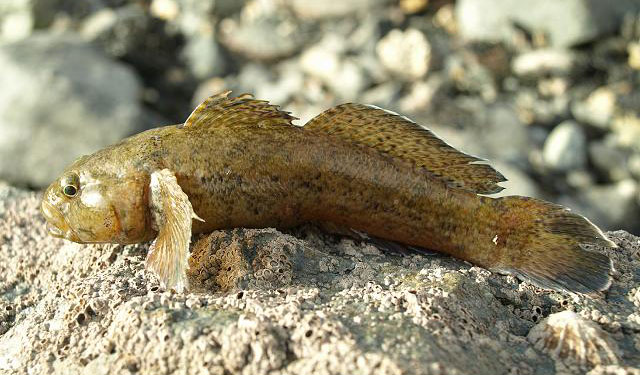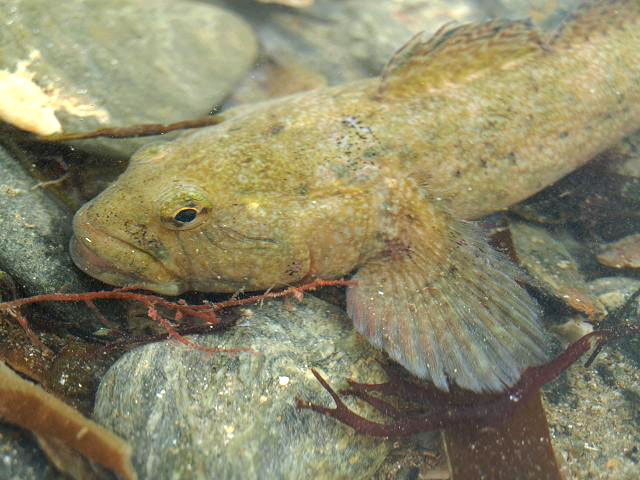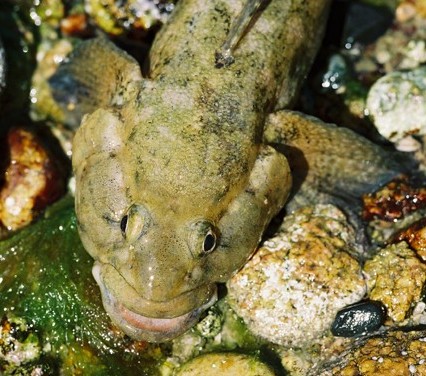
 |
Two small sandy coloured
gobies of shallow sandy pools and estuaries:
 Photograph
by Andy Horton
Photograph
by Andy Horton
Common Goby
Scientific Name:
Pomatoschistus microps
Family: Gobiidae
Usual Size: 64 mm
Identification:
Small goby (a family of
small fishes with a notorious reputation of being difficult to differentiate,
characterised by a pair of dorsal fins, and a pelvic fin fused into a weak
suction cup).
Sandy colour, but not so
long as the similar species Pomatoschistus minutus. In breeding
coloration the male fish has a dark blotch at the rear of the first dorsal
fin. Only experienced rockpoolers are likely to be able to separate these
species in the wild.
Similar Species:
Sand Goby, Pomatoschistus
minutus.
Breeding:
Spring. May lay eggs up
to five times under a shell. Male guards the eggs. Life span 12 - 15 months
only.
Habitat: Sandy shallows, intertidal with shallow sandy pools, estuaries in summer.
Food:
Small crustaceans like caprellids,
worms.
Range:
All British coasts.
Additional Notes:
Abundant.
Scientific Name:
Pomatoschistus minitus
Family: Gobiidae
Usual Size: 94 mm
Identification:
Small goby (a family of
small fishes with a notorious reputation of being difficult to differentiate,
characterised by a pair of dorsal fins, and a pelvic fin fused into a weak
suction cup).
Sandy colour but longer*
than the similar species Pomatoschistus microps. In breeding coloration
the male fish has an occelated spot at the rear of the first dorsal
fin. Only experienced rockpoolers are likely to be able to separate these
species in the wild.
*distance from the last second dorsal fin ray to the tail fin is proportionately greater than in P.microps.
Similar Species:
Common Goby, Pomatoschistus
microps.
Breeding:
Summer.
Habitat: Sandy shallows, intertidal with shallow sandy pools, estuaries in autumn.
Food:
Small crustaceans like caprellids,
worms.
Range:
All British coasts, North
Sea, Mediterranean.
Additional Notes:
Abundant.
Two medium sized gobies of large pools and under rocks
Small goby of the weedy pools

Photograph by Luke Richards (Isle of Wight)
Gobiusculus flavescens, Two-spotted Goby. Photographed with great difficulty at Tjärnö Aquarium by Mike Noren.
A photograph of a shoal of 2-Spot Gobies by Paul Parsons.
Small goby, abundant offshore and occasionally stranded in pools.
Two black spots can be seen
clearly on the transparent boby, one near the head and one near the tail
fin.

Other gobies that are rarely found:
Their rarity in Britain is because they are on the northern edge of their natural distribution based on water temperature for breeding. In the south, probably because they are eaten or go into bouillabaisse. Also, their bathymetric zone is probably in shallow water, and not normally intensively fished, and not encountered by rockpoolers except on the low spring tides, or under rocks too large to shift.
I found
two Giant Gobies, Gobius
cobitus. at Roskilley, south of Newlyn;
in a small middleshore pool, 100cm x 100cm (open space), no green algae
cover, but there was a very deep crevice under a large rock. On watching
them I was amazed at how rapidly they can change colour from dark brown
to olive green depending on the bottom / from shade to light. They were
both easily teased out their hole with a little mackerel
flake.
''I
passed the pool the day before and heard a large splosh from it. I went
back
with a little mackerel to tease the fish out from under the large rock
they
were under to see what the fish were, as I suspected Giant Goby. Fish
in
image is approx. 9 inches in length.''
Report and Photograph by David Fenwick Snr. (Aphotomarine)
 |
 |
Giant Goby
Photographs
by David Fenwick Snr.
(Aphotomarine)
On going back up Marazion Beach, south Cornwall, as the tide turned (on the lowest tide of the year) my partner and I looked around some uppershore pools and discovered five Giant Gobies, Gobius cobitus. in three small pools. They averaged about 18 cm in length.
September
2009
A
Giant
Goby, Gobius
cobitus, was photographed in a rockpool
at Gerrans,
south Cornwall.
27
September 2008
I
was fishing near Treyarnon
Bay south of Padstow,
Cornwall, and caught a Giant Goby, Gobius
cobitus. I have been fishing for 30 odd years
and have not seen the like of it before. It was about 20 cm long and its
identity was confirmed from internet image searches. It was safely unhooked
and returned to the sea.
26
July 2008
I
found a Giant Goby, Gobius
cobitus, in a rockpool at Portholland
beach, south Cornwall. I wasn't sure exactly what it was as it was so large,
although I knew it was a goby! Having googled the subject I was interested
to see which type it was, and that they appear to be protected. This
one was in rude health, and was released of course following some photography.
I didn't have the good fortune to have a ruler with me but would estimate
the fish to be approx 20 cm long. I have been an avid rockpooler
for 40 years and I have never seen one before.

31
January 1998:
A Giant Goby, Gobius
cobitus, was discovered by Jon Makeham at Hannafore
Point, Looe, in southern
Cornwall. It was found sheltering underneath a piece of Japweed,
Sargassum
muticum, on the middle shore. This large goby at 25 cm long,
is at the northern edge of its range in the SW of Britain and is rarely
found between the tides.
This goby is now a protected species (since 1998).
Wildlife & Countryside Act 1981, Species Protection
Schedule
5
Protection
for wild animals on Schedule 5 of the Wildlife
and Countryside Act
Section
9
Part 1 intentional killing, injuring, taking
Part 2 possession or control (live or dead animal, part or derivative)
Part 4 (a) damage to, destruction of, obstruction of access to any structure
or place used by a scheduled animal for shelter or protection
Part 4 (b) disturbance of animal occupying such a structure or place
Part 5 (a) selling, offering for sale, possessing or transporting for the
purpose of sale (live or dead animal, part or derivative)
Part 5 (b) advertising for buying or selling such things
 |
 |
19
April 2003
The
discovery of a Giant
Goby, Gobius cobitis, found in
a rockpool above the half tide mark at Les Écréhous, Jersey,
was a notable discovery. This goby is a protected
species under the Wildlife
and Countryside Act Schedule 5. It has
always been known from the shores of Jersey but it is virtually unknown
on the northern English Channel coasts with occasional records from Cornwall
only. As it name indicates this goby is a 'giant' amongst the Gobiidae,
a family of small fishes. The Giant Goby attains lengths of up to 25 cm.
English
Nature & MBA articles on Giant Gobies (the link no longer works)
Marlin
on the Giant Goby
14
March 2003
I have photographed a Giant
Goby at Pendennis Point, Falmouth, Cornwall.
Another
Image (Link)
This goby is common in some areas below low tide mark, and conceivably could be discovered betweeen the tides, but few reports of this fish from the shore have been received by the BMLSS. Jim Hall reports this fish on very low tides from Tenby, SW Wales. There are frequent reports from divers from NE Scotland to Devon, so the fish must be widespread below low water mark.
Pomatoschistus pictus Painted Goby. Note the two dark band on the dorsal fin. Size about 2.5cm. Photographed at Tjärnö Aquarium by Mike Noren.
This goby with a local distribution is so similar to Gobius niger that I cannot distinguish the species.
Crystal Goby Crystallogobius linearis
A photograph of this pelagic goby can be found on the following web site:
Lesuerigobius friesii have been reported living with the Scampi Prawn, Nephrops norvegicus, in the same burrows.
Differences
between Blennies & Gobies
British
Blennidae
BMLSS
Fish page
Dr
Peter Miller (Homepage)
Mediterranean
Gobies (including British species) by Robert Patzner
Gobies
and Blennies Photographic Portfolio
(Marine
Wildlife of the North-east Atlantic Ocean Group)
|
|
|
|
|
News 2018 |
Membership Form |
|